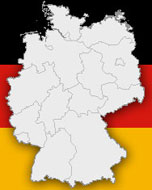In 2008, even as Americans argue over whether renewable energy is a fantasy, Germany generated 14.2% of its electrical power from renewable resources. Already a leading player in so-called clean technology — the mix of environmentally benign power generation and environmentally friendly technologies — Germany may become the epicenter of the world’s next industrial revolution: the triumph of clean, cheap, sustainable electricity.
This article looks at how the German government and individuals helped such companies as Enercon, the world’s third-largest producer of wind generators, and Q-Cells, the world’s largest producer of photovoltaic cells, reach their present position, and what their gains might mean for the country and the world.
Bigger than Cars
At a time when most countries have hardly begun installing power-generating windmills, Germany has already installed 23,900 megawatts, making it the world’s largest home of windmills per capita. Germany also has an installed base of 3,830 megawatts of photovoltaic cells, making the country a world leader in solar power as well, despite its famously wet climate.
Already, renewable technologies provide some 170,000 jobs to the German economy. By 2020, some analysts estimate that clean technology, or “clean tech,” will be an even bigger industry in Germany — and globally, an industry rivaling or exceeding IT in historical importance. Products are good enough already that the installed base of solar panels and wind mills keeps climbing rapidly, and technological advances seem likely to accelerate that process.
Würth Solar of Marbech, for instance, is now at work on thin-film photovoltaic cells that can convert up to 12% of the sunlight they receive into energy, a technology that may prove to be lighter and cheaper to mass-produce than traditional photovoltaic cells. Nanotechnology researchers at the Fraunhofer Institute for Solar Energy Systems have invented a new kind of cell that has a much lower efficiency rate but on the other hand, is simply a layer of dye which — in combination with some nano particles printed on the circuit — produces electricity.
The home market may be only the beginning. The European Union has challenged itself to generate 20% of its electricity from renewable sources by 2020. Solar itself may be just three or four years away from being truly cost-competitive with other forms of power. According to a Piper Jaffray analyst, when solar power becomes competitive with conventional power, “demand becomes infinite.”
Origins of Clean Tech
Although parts of Germany have long been extremely industrial, more than 85% of the country is forested or farmed, and Germans have long cared about the environment. The country’s leadership in eco-friendly technologies stems from tough air and water pollution laws passed in the 1970s, which encouraged the development of advanced treatment systems and other ‘end of pipe’ solutions, according to Klaus Rennings, senior researcher in environmental resource economics and environmental management for the Mannheim-based Centre for European Economic Research.
More recently, some trace the growth of Germany’s environmental conscience to an event that happened beyond its borders: the meltdown at Chernobyl, Ukraine, in 1986. The disaster reportedly had a profound effect on Germans’ environmental consciousness. Living downwind from Chernobyl, Germany received some of the wide plume of radioactive fall-out that fanned out all over northern Europe. Direct health effects have apparently been minimal in Europe, but the incident led many Germans to feel that the environment was not only in a precarious condition, but that it mattered.
The question of a clean environment was not merely aesthetic: many Germans began to feel that permitting the environment to degrade any further might lead to problems that could directly affect their own health and safety. One measure of this: both large corporations, such as Siemens, and unions favor strong conservation and alternative energy measures, according to Wharton management professor Mauro Guillen.
Germany’s Green Party benefited from the new level of concern and began to win more state elections. Between 1998 and 2005, the party shared power at the federal level with the Social Democratic Party in a so-called red/green alliance. With their new clout, the Green Party pushed through major changes to the government’s energy and recycling policies. The Greens lobbied for the creation of a number of incentives to drive environmentally-friendly industrial development and alternative energy. Today, many of these companies are coming of age. Some foreign policymakers are looking at the way the governmental mandates were implemented for some clues about how to jumpstart their own clean-tech sector.
Nor has that pressure ever gone away. Just as the hyperinflation of the Weimar Republic left many Germans suspicious of credit for generations, so the experience of being downwind from a large nuclear accident seems to have made them nervous about their environment. Susanne Shields, director of the German culture and language program of Wharton’s Lauder Institute, says that in their tours of German companies, her students are struck by the stress so many companies place on their own green agenda. “That’s something they are usually impressed by,” she says.
“Many firms have made a major commitment to develop alternative energy sources,” agrees Jerry Wind, a professor of marketing at Wharton. “Other companies who are primarily energy consumers have a similar commitment.” Berlin alone, he notes, now has more than 30 research institutes and 1,000 companies dedicated to alternative energy production or green development.
The biggest reason the alternative energy sector has grown so quickly, in the view of some experts, is that the government created some simple but generous incentives for companies to produce electricity through means such as solar power or wind. By requiring electric utilities to buy power produced by the alternative producers at a set price, the government effectively guarantees a long-term set return for alternative energy production.
Setting a Floor Price
The advantage of this approach, as opposed to the tax credit style of incentives more familiar to U.S. business, is that it gives a free energy producer the ability to project business growth outwards over a number of years. Rather than suffer the slings and arrows of outrageous commodity prices — profiting when fuel prices are high and losing revenues when they fall — the German approach provides a floor price that makes it possible for alternative energy businesses to plan for the future. This is especially true in the case of wind power, according to Guillen. The reason is that because there is no cost for the “fuel,” a fixed price for power makes it easy for planners to project the profitability of a plant — a task almost impossible in a highly price-volatile market.
This approach also ensures that developers of wind farms are companies that are genuinely interested in power development, which is not always the case in the U.S. “The wind farms in the U.S. get sold to companies not necessarily in the energy sector but companies that have large profits,” Guillen notes. He argues that while subsidies always lead to economic distortions, the tax credit approach leads to even greater distortions in this area.
Government regulation has helped the industry in other ways as well, according to Rennings, the environmental economics researcher. Rennings argues that Germany’s leading-edge regulations against pollution have led German companies to develop expertise and technology that they can sell to businesses in countries that are just adopting tougher regulations. First, Europe as a whole began emulating Germany, and now China is emulating Europe.
A third reason clean tech is succeeding in Germany, experts say, is because it plays into the country’s traditional strengths in engineering and physical technologies. Unlike, for example, information technology, clean tech depends on Germany’s traditional command of chemistry, physics and precision instruments.
The success may also be due to the fact that saving energy-saving anything — appeals to Germans’ traditionally thrifty nature. The idea that wind, for example, is just there for the taking, is somehow especially appealing to Germans. “It’s not the land of plenty,” says Saikat Chaudhuri, a professor of management at Wharton. “You don’t have lots of space. You use what you have in the most efficient form.”
Guillen notes, for instance, that Germans have been told that if they are going to be stopped in traffic for more than a minute and a half, they should turn off their car engines in order to save fuel. “They actually do it,” he says. “Just imagine!”
This thriftiness has been an important part of public support for environmental measures in Germany. Scholars say that even in the early 1970s, Germans saw higher automobile exhaust standards not as an added cost, but as a way to save fuel. They also considered pollution as a general burden on the land, a dirtying of the land (Verschmutzung) rather than an observed damage, as the British, for example, tended to see it.
In other respects too, the clean tech sector seems to owe something to the market in which it has grown. One of the most notable qualities is the absence of a stock mania around it. Although for at least the last 40 years, Germans have felt optimistic that environmental protection, technical progress and economic growth aren’t mutually exclusive goals, there also seems to be a sense that this is the work not of months or years, as sometimes felt the case during the Internet bubble, but of decades.
And it will remain a get-rich-slow business, predicts Jürgen Habichler, head of Mountain Cleantech, a firm that specializes in ecological investments — not quite the outcome most venture capitalists seek. “Clean tech — it’s a different market. We deal with different people, a different mindset compared to the Googles and Microsofts of this world,” he says.
The truth is that as promising as clean tech seems, a lot of hard work lies ahead, both technical and economic. Logistical problems remain, for one thing. It’s easy for legislators to mandate that utilities accept energy produced, say, from a windmill, but more difficult for engineers to design electrical systems that can accommodate the wide swings in power produced by some alternative sources of energy.
Wind turbines, for example, generate much more power in a high wind. While overall, clean energy provides about 9% of the total energy in Germany, according to various sources, wind speed can vary a great deal. In Spain, for instance, the amount generated varies from 15% to 25% of the total electricity generated, depending on the wind. For a utility, this can pose a problem, since it’s not always easy to shut down a coal-fired power plant and then restart it a day later when the wind dies down, Guillen says.
For another, there are economic concerns. First, and most immediately, the price of hydrocarbons has fallen by about two-thirds since last summer. Second, as long as renewable energy depends on government subsidies, the industry is vulnerable to political reversal. How — and when — the industry should be weaned is a cause for ongoing debate among economists, according to experts.
When Green Grows Up
Despite the technical challenges, some business scholars believe that the green boom is only beginning and will eventually be one of the great technological shifts of our age. Jeremy Rifkin, a futurist and teacher in Wharton’s executive education programs, contends that what is going on in Germany and other places in Europe right now is not just the creation of cleaner ways to generate electricity, but the foundation of a third industrial revolution.
Rifkin claims that just as in the 19th century, when the invention of the internal combustion engine combined with electrical communications to create an entirely new world of production and transportation, so now the birth of satellite communications and the Internet have prepared the way for new power generation technologies based on distributed rather than centralized power generation.
In contrast to many forecasters, Rifkin argues that these new technologies won’t mean getting along with less power, just producing it in different and more efficient ways. “Just as second generation information systems grid technologies allow businesses to connect thousands of desktop computers, creating far more distributed computing power than even the most powerful centralized computers that exist, millions of local producers of renewable energy … can potentially produce far more distributed power than the older centralized forms of energy — oil, coal, natural gas and nuclear — that we currently rely on,” he said in a lecture last year.
Wind agrees that something big is going on in Germany right now in terms of alternative energy and green development. “They’re doing it,” he says. “The reality is, they’re moving forward.”



